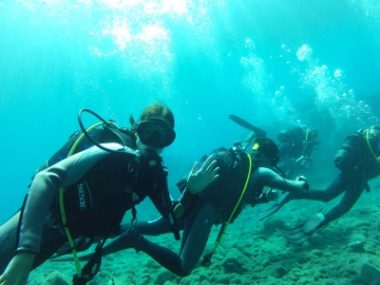What I miss from our life before ankylosing spondylitis
A couple searches for new adventures even as AS limits their abilities
Written by |

Last night, as I was drifting off to sleep, I was picturing swimming underwater with my diving tank on my back. Imagine sinking down through cool, shimmering water while kicking your fins to propel yourself slowly toward the white, sandy bottom of the ocean. Incredible coral formations are close by, jutting out from the sea floor like intricate cities filled with busy, brightly colored fish. It’s utterly captivating.
My husband, Dave, and I took many diving trips around Australia and Greece in our 20s and 30s, but it’s not an activity I’d dare to try anymore. The ability to trust my body on an adventure is one of the things I miss most about our lives before we were both diagnosed with ankylosing spondylitis (AS).
As wonderful as diving is, it can be risky and strenuous. The air tanks and gear are heavy and cumbersome out of the water, and you need physical strength to swim back (sometimes against the tide) and climb precariously into the boat as waves crash into you.

Jemma waves happily as she dives off the island of Santorini, Greece, in 2014, before she was diagnosed with ankylosing spondylitis. (Photo by Dave Newman)
Though I yearn to have adventures like diving again, I feel nervous at the thought of having to rely on my body to get me out of a risky situation. Because AS affects some of the joints near our core, including the spine and sacroiliac joints, the wrong weight-bearing exercise could cause excruciating pain. I don’t even want to think about being at the bottom of the ocean, unable to swim to the surface. It’s the stuff of nightmares.
Some people with AS might be strong enough to push through that pain, but I don’t want to put myself in that situation. And because both Dave and I have AS, we can’t expect each other to save the day or take on the physically taxing parts of an adventure.
While I don’t identify as disabled, I’ve found that I can empathize with folks living with a disability. It’s frustrating to have a condition that stops you from participating in physical activities that many others enjoy and often proudly display on social media. As I watch our friends mountaineer, rock climb, and snowboard, I feel wistful.
However, we’re lucky to have tasted adventure in our lives, and it seems unfair that some have to miss out entirely.
Recently, I chatted with a man who builds mountain bikes for paraplegics in his spare time. His face was beaming with excitement as he explained his new design to measure the space between trees, ensuring the modified bikes can navigate the trail safely. Though these bikes are expensive, the value to disabled riders must be immeasurable. Imagine experiencing the thrill of the trail after being denied that passion for many years.
The bike builder’s dedication and delight were inspiring. Clearly, adventures are still possible if you have the right strategy and take steps to mitigate risk.
Because Dave and I can no longer trust our bodies to push through physical challenges, we need to approach adventures with careful planning. Sure, that’ll mean fewer spontaneous “let’s give it a whirl and see what happens!” events, but I’m interested in trying to organize a new kind of adventure.
Note: Ankylosing Spondylitis News is strictly a news and information website about the disease. It does not provide medical advice, diagnosis, or treatment. This content is not intended to be a substitute for professional medical advice, diagnosis, or treatment. Always seek the advice of your physician or other qualified health provider with any questions you may have regarding a medical condition. Never disregard professional medical advice or delay in seeking it because of something you have read on this website. The opinions expressed in this column are not those of Ankylosing Spondylitis News or its parent company, Bionews, and are intended to spark discussion about issues pertaining to ankylosing spondylitis.







George
You're still young, but I'm not. I've done a great amount of swimming, but not under water. I've ridden a bike thousands of miles, fast, as it was another love. I won't anymore because I can't take the risk, and it's high risk. I might resume swimming if I feel my neck can take it. Running, jogging, is surprising good though. Being older, people that don't know better fail to realize the multitude of great benefits of running. They believe it will hurt your knees. Sure if you run too often, if you're overweight or otherwise not built for running, wear the wrong shoes (feet need a good platform, and not tight either), or if you run downhill. Running uphill is great, but walk down.
Yes I have to avoid most social activities due to my unreliable at given times circumstance, so planned group activities (like you discuss here) are few for me anymore. But I am overjoyed that I can still run. For years I couldn't due to severe AS and the compression pain in my chest that was like a straightjacket. My sacroiliac pain was very bad at times too, but I'm thankful that my rheumatologist knew that (sacroiliac inflammation) didn't prevent me from being able to run. He was right. After I had started with biologics, I eventually could run, but I had to constantly stop and walk before I resumed running. So more time was spent walking. Eventually, after years, no more sacroiliac pain. Eventually, after years, no more chest compression pain and I could run continuously again. I am so happy for that. It's makes accepting what I can't do so much better. Running has gotten a bad rap - it is verified anti-aging. Particularly if you have AS, or are older, you have to give yourself many days (even a week if necessary) between runs to allow your body to heal. Running too often (it's not the distance) is what turns a good thing into a bad one.
Being young, you may be capable of most physical activities. With AS, it's highly individual. You have to figure it out for yourself. For me, it's in determining how much recovery time I need, and that was twice as long as everyone else even when I otherwise had few limitations.
Jemma Newman
George, thanks for your wonderfully detailed reply! I love hearing about your running, and you have some really good tips to share. Interesting that you mentioned the need for extra recovery time with AS too, I absolutely agree.